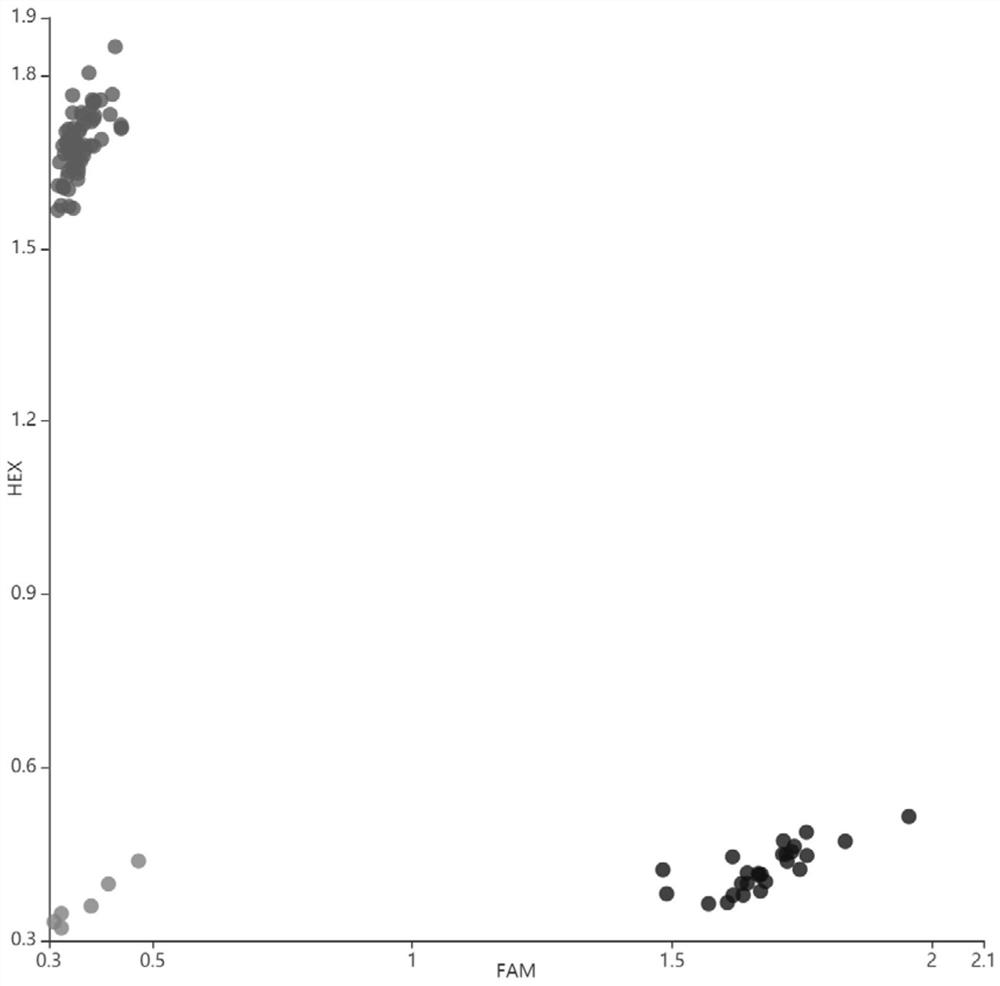PARMS marker based on SNP mutation of coding region of rice blast resistance gene Pid2 and application
A rice blast and resistance gene technology, applied in the field of PARMS marker and application, can solve the problems of inappropriate large-scale genotype analysis, use of toxic substances, low degree of automation, etc. Easy to grasp effect
- Summary
- Abstract
- Description
- Claims
- Application Information
AI Technical Summary
Problems solved by technology
Method used
Image
Examples
Embodiment 1
[0036] The PARMS marker and application based on the SNP mutation in the rice blast resistance gene Pid2 coding region include the following steps:
[0037] 1) Identification of blast resistance of rice materials: Using Nipponbare as a control, 226 rice materials were artificially inoculated at the seedling stage to identify the resistance to blast disease, and the material Y127 resistant to blast disease races ZA9 and ZA13 was screened out;
[0038] 2) Analysis of Pid2 gene structure: The DNA of fresh leaves of Y127 and Nipponbare was extracted by CTAB method, amplified in segments, purified and then sent to the biological company for sequencing. The software Vector NTI 11 was used to analyze the difference of Pid2 gene in the two rice materials. A→G mutation occurred at the 555bp site in the coding region of the gene (see attached figure 1 );
[0039] 3) Design and synthesis of Pid2 gene functional markers: According to the G→A mutation at position 555 of the Pid2 coding r...
Embodiment 2
[0060] The PARMS marker and application based on the SNP mutation in the rice blast resistance gene Pid2 coding region include the following steps:
[0061] 1) Identification of blast resistance of rice materials: using Nipponbare as a control, 200 rice materials were artificially inoculated at the seedling stage to identify the resistance to blast disease, and the material Y127 resistant to blast disease races ZA9 and ZA13 was screened out;
[0062] 2) Analysis of Pid2 gene structure: The DNA of fresh leaves of Y127 and Nipponbare was extracted by CTAB method, amplified in segments, purified and then sent to the biological company for sequencing. The software Vector NTI 11 was used to analyze the difference of Pid2 gene in the two rice materials. An A→G mutation occurred at the 555bp site in the coding region of the gene;
[0063] 3) Design and synthesis of Pid2 gene functional markers: According to the G→A mutation at position 555 of the Pid2 coding region, a PARMS molecular...
Embodiment 3
[0076] The PARMS marker and application based on the SNP mutation in the rice blast resistance gene Pid2 coding region include the following steps:
[0077] 1) Identification of blast resistance of rice materials: Using Nipponbare as a control, 250 rice materials were artificially inoculated at the seedling stage to identify the resistance to blast disease, and the material Y127 resistant to blast disease races ZA9 and ZA13 was screened out;
[0078] 2) Analysis of Pid2 gene structure: The DNA of fresh leaves of Y127 and Nipponbare was extracted by CTAB method, amplified in segments, purified and then sent to the biological company for sequencing. The software Vector NTI 11 was used to analyze the difference of Pid2 gene in the two rice materials. A→G mutation occurs at the 555bp site in the coding region of the gene;
[0079] 3) Design and synthesis of Pid2 gene functional markers: According to the G→A mutation at position 555 of the Pid2 coding region, a PARMS molecular mark...
PUM
 Login to View More
Login to View More Abstract
Description
Claims
Application Information
 Login to View More
Login to View More - R&D
- Intellectual Property
- Life Sciences
- Materials
- Tech Scout
- Unparalleled Data Quality
- Higher Quality Content
- 60% Fewer Hallucinations
Browse by: Latest US Patents, China's latest patents, Technical Efficacy Thesaurus, Application Domain, Technology Topic, Popular Technical Reports.
© 2025 PatSnap. All rights reserved.Legal|Privacy policy|Modern Slavery Act Transparency Statement|Sitemap|About US| Contact US: help@patsnap.com


